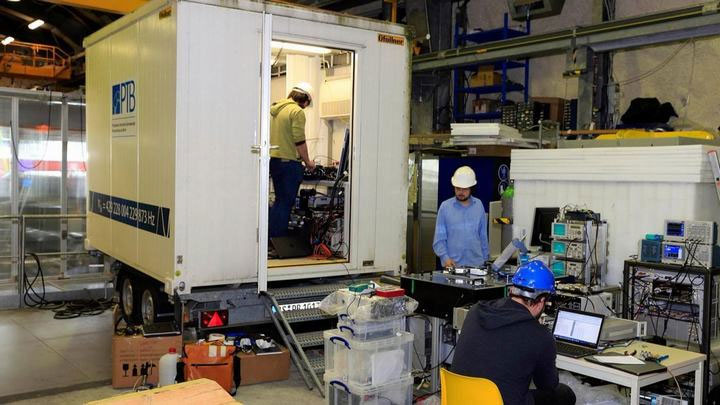When scientists bring atomic clocks to measure ... the height of the mountain
We often think of time as a unit that measures things like dates, long life measurements, and so on. But if you own a pair of clocks that are extremely accurate, you can use time to measure something else - measure the height of the mountains.
According to the Los Angeles Times, scientists took a big step last week in using the time to measure sea level and above. For the first time in history, they brought a whole set of optical atomic clocks out of the lab. This watch is taken to the Alps, France.
By comparing the speed ratio of an atomic clock placed on a mountain with an analog clock in a laboratory in Turin (Italy), researchers have shown that the difference is The height between the two locations is about 1,000 meters, or 3,280 feet. This research topic has been published in the Natural Science journal.

A new atomic clock is capable of using gravity to measure the height of a mountain in the French Alps.(Photo from Jean-Pierre Clatot / AFP-Getty Images)
Duncan Agnew, a geophysicist at Scripps Oceanographic Institute in San Diego, said: "The idea of using a watch in this way has existed in geophysical documents for a long time. What those That researcher is merely doing that in real life. "
According to Einstein's theory of relativity, travel time varies depending on where you are in the gravity field. For example, a high mountain clock - far from the center of the Earth - will move faster than a little clock at the bottom of the mountain, where gravity is stronger. It is not a mechanical error. Time really faster when on the top of the mountain.
In other words, people living in the mountains will age a little faster than those who live on the beach.

Clocked strontium optical transport in Modane Underground Underground Laboratory.(Christian Lisdat).
"Your body ages, changes appear to exist in real time no matter where you are , " said Christian Lisdat, a physicist at the German National Metrology Institute. "And no different from watches."
Most of the current watches are not accurate enough to mark the difference in time speeds at different heights. Because, in 10 years, two meters separated by 1,000 meters by height will be only 31 milliseconds apart, Agnew said. But an atomic clock is capable of splitting a second into very tiny parts that can help detect a small change in time speed. Since 1655, the recording of time is to build something that vibrates at a constant rate - whether using pendulum or vibrating quartz crystals if you bring electric current through them.
also. They use the quantum leap of electrons as a pendulum."These steps are a very basic property of atoms, and these steps are the same for each atom of the same type," Lisdat said. "Whatever type of substance you use, where in the universe, you have the same frequency as the pendulum." Some of the most accurate clocks on the planet are devices called optical mesh clocks . They measure the movement of electrons around strontium particles that have been trapped in a laser grid. With this setting, a detachable optical mesh clock is split into 9 billion cycles per second.

Christian Lisdat, a physicist from the German National Metrology Institute.
However, watches with this level of accuracy are often located in the laboratory. This makes it difficult to carry away, because the vacuum chamber must be maintained, cooling strontium atoms to temperatures near absolute zero, creating a network of highly concentrated laser beams and hundreds of mirrors. reflection, etc.
Even so, Lisdat and his colleagues want to build an optical mesh watch that can be carried on the road. The key is to determine the factors to balance the mass of stars but also to allow the clocks to get out of the lab without losing too much precision."What we do is bring something artistic and make it transportable," Lisdat said. "It's not easy."
Finally, the team divided the optical clock into small parts suitable for packaging on a car with a temperature stability and withstands great shock, and small enough to fit into the storage compartment. two horses . "It's like you pack a small lab to take away," Lisdat describes.

Inside the laboratory, no atomic clock can be moved.(Christian Lisdat).
The first test, the authors brought their new portable watch to the Souterrain de Modane laboratory, a laboratory buried deep in the French Alps. Using an optical fiber link, they are connected to each other around 88km in Torino."We choose two relatively large elevations to test the most effective," Lisdat said.
The first experiments did not go smoothly. At that time, a new tunnel was being underground in the mountain, and nearby drills lost the stability of the watch.
In addition, low humidity and warmer temperatures are expected to make the preservation of clock components much more difficult. However, they were able to tell that the watch was 1,000 meters taller than the other one in Torino. Finally, when the accuracy of the portable watch continues to increase, time can be used to measure the height difference from about 1 cm.
Despite many difficulties, this study is considered to be useful for building improved navigation systems and technical projects. Lisdat also said that he will continue to work with this research and create new improvements in the future.
- China has produced optical clocks
- The most accurate atomic clock in the world
- Nepal calls for help measuring Everest height
- You can know the height and strength of a person by hearing them scream
- Watching the clock for 14 years is a way to prove Einstein's theory
- US made the world's most accurate atomic clock set a new record
- Rare earth elements can help redefine time
- Japan made the world's most accurate watch pair
- June 30: The first second in history is added and the endless race begins
- Old ancient stones measure wrongly for millions of years!
- Mountain sickness is a combination of 2 diseases
- the science story about the watch
 'Fine laughs' - Scary and painful torture in ancient times
'Fine laughs' - Scary and painful torture in ancient times The sequence of numbers 142857 of the Egyptian pyramids is known as the strangest number in the world - Why?
The sequence of numbers 142857 of the Egyptian pyramids is known as the strangest number in the world - Why? History of the iron
History of the iron What is alum?
What is alum? Why are 76% of rich people introverts?
Why are 76% of rich people introverts?  What time of day is the easiest to fish?
What time of day is the easiest to fish?  Shocking Research: It's Possible to Stop Time
Shocking Research: It's Possible to Stop Time  Closed 'time tunnel' waiting to open after 6,000 years
Closed 'time tunnel' waiting to open after 6,000 years  The Time Stop Illusion: Why Do Clocks Sometimes Appear to Stop?
The Time Stop Illusion: Why Do Clocks Sometimes Appear to Stop?  Why do doctors have to remove appendix before going to Antarctica?
Why do doctors have to remove appendix before going to Antarctica? 